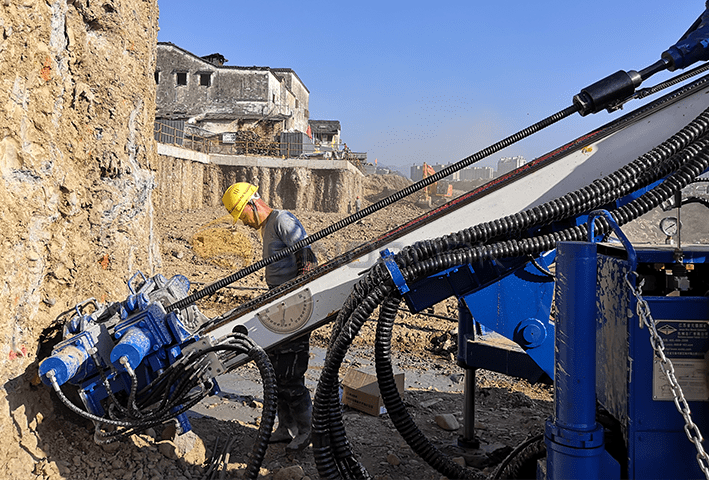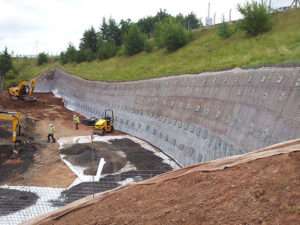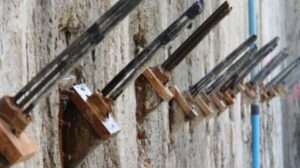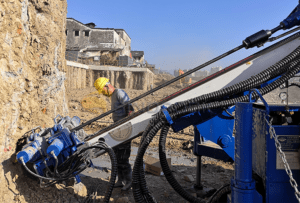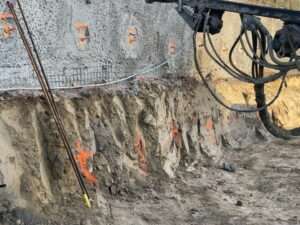In civil engineering, ensuring stability and safety in slope and foundation projects is paramount. As construction takes place on increasingly challenging terrains, innovations in geotechnical solutions become essential. One such innovation is the self-drilling anchor (SDA) system, which has gained significant traction for its versatility, efficiency, and ability to provide reliable reinforcement in both slope stabilization and foundation engineering. This article explores the applications, advantages, and technical considerations of self-drilling anchors in these critical areas.
What Are Self-Drilling Anchors (SDAs)?
Self-drilling anchors are composite ground support systems designed to reinforce unstable slopes, retaining walls, tunnels, foundations, and other structures in geotechnically challenging conditions. SDAs consist of a hollow, threaded steel bar with a sacrificial drill bit at the end. The system allows for simultaneous drilling and grouting, eliminating the need for a pre-drilled hole.
SDAs can penetrate difficult ground conditions, such as fractured rock, loose soil, or soft clay, and offer an efficient solution when traditional drilling techniques are not feasible. Their self-drilling capability ensures quicker installation, and the integration with grout provides enhanced load-bearing capacity.
Applications in Slope Engineering
1. Landslide Prevention and Slope Stabilization:
In slope engineering, the risk of landslides, especially in areas with loose soil or high moisture content, poses significant threats. Self-drilling anchors provide effective reinforcement by penetrating weak layers of soil or rock, anchoring deeply to more stable strata. By anchoring unstable slopes, they prevent soil movement, which mitigates landslide risks.
2. Roadside Embankment Support:
In transportation infrastructure, road embankments often require slope stabilization to prevent erosion and collapse. SDAs are frequently used to reinforce these embankments, creating a stable platform for roadways and protecting against potential slope failures. The rapid installation process makes them particularly suited for projects where time constraints are crucial.
3. Retaining Walls and Cut Slopes:
During the construction of highways, railways, or other infrastructure requiring cut slopes, SDAs are employed to stabilize vertical cuts in soil or rock. The self-drilling anchors work in conjunction with retaining walls, offering additional support to resist lateral earth pressures that could otherwise cause structural failure.
Applications in Foundation Engineering
1. Deep Foundation Support:
For structures built on soft or unstable ground, SDAs can be used as a reliable deep foundation support system. The anchors penetrate deep into the underlying stable strata, transferring the load of the structure to competent soil or rock layers. This provides a stable foundation even in geotechnically complex conditions.
2. Underpinning Existing Structures:
In urban areas where structures need to be reinforced or stabilized, self-drilling anchors are ideal for underpinning existing foundations. The anchors can be installed without causing major disruptions to the building above, and their self-drilling capability allows for efficient installation even in limited-access environments. This makes them an attractive option for retrofitting and reinforcing aging infrastructure.
3. Foundation Pit Support:
When constructing basements, tunnels, or other deep excavations, self-drilling anchors provide essential support for foundation pits. SDAs stabilize the walls of these pits, preventing collapse or deformation during excavation, which ensures the safety of both the structure and the construction workers.
Advantages of Self-Drilling Anchors
1. Efficiency and Speed:
One of the most significant advantages of self-drilling anchors is the reduced installation time. Because drilling and grouting are simultaneous, construction teams can complete projects faster than with traditional anchoring systems. This is particularly important in emergency slope stabilization or projects with tight deadlines.
2. Versatility in Various Ground Conditions:
Self-drilling anchors are effective in a wide range of ground conditions, including loose soils, gravels, and fractured rock. Their ability to drill through difficult terrain makes them adaptable to a variety of geotechnical challenges, ensuring reliable performance across different project types.
3. Enhanced Load-Bearing Capacity:
The integration of SDAs with grout creates a composite structure that offers superior load-bearing capacity. The grout increases the diameter of the anchor, improving its bond with the surrounding soil or rock, which ensures long-term stability and reinforcement.
4. Minimal Site Disruption:
SDAs can be installed in limited-access or confined spaces, making them ideal for urban environments or projects where minimizing disturbance is a priority. This characteristic also makes them suitable for retrofitting and emergency repairs.
Technical Considerations and Best Practices
When applying self-drilling anchors in slope and foundation engineering, it is essential to conduct a thorough geotechnical analysis. Engineers must assess soil conditions, load requirements, and other environmental factors to determine the appropriate anchor length, diameter, and installation technique. Additionally, proper grout selection and quality control during installation are critical to ensuring long-term performance.
The use of SDAs in harsh environments, such as those with corrosive soils or fluctuating water tables, requires careful consideration of corrosion protection measures, such as hot-dip galvanization or encapsulation in protective coatings.
Conclusion
Self-drilling anchors have revolutionized slope and foundation engineering by offering an efficient, versatile, and effective solution for ground reinforcement. Their ability to adapt to a wide range of geotechnical conditions makes them a valuable tool in the construction of safe and stable infrastructure, especially in challenging environments. As the need for advanced geotechnical solutions continues to grow, SDAs are likely to play an even more critical role in ensuring the success of modern engineering projects.


